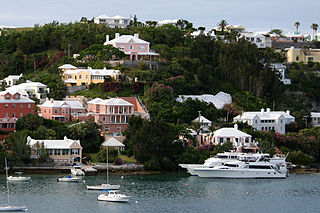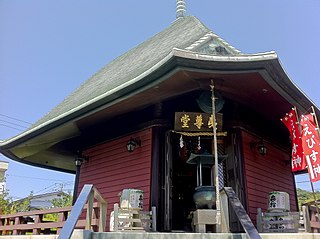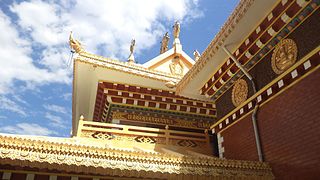Related Research Articles

A roof is the top covering of a building, including all materials and constructions necessary to support it on the walls of the building or on uprights, providing protection against rain, snow, sunlight, extremes of temperature, and wind. A roof is part of the building envelope.

In architecture, a cornice is generally any horizontal decorative moulding that crowns a building or furniture element—for example, the cornice over a door or window, around the top edge of a pedestal, or along the top of an interior wall. A simple cornice may be formed just with a crown, as in crown moulding atop an interior wall or above kitchen cabinets or a bookcase.

Eavesdropping is the act of secretly or stealthily listening to the private conversation or communications of others without their consent in order to gather information.

A soffit is an exterior or interior architectural feature, generally the horizontal, aloft underside of any construction element. Its archetypal form, sometimes incorporating or implying the projection of beams, is the underside of eaves. The vertical band at the edge of the roof is called a fascia.

Woodhouse Eaves is a village located on the side of Beacon Hill, in the Charnwood Forest area of Leicestershire, England. It has a mixture of small and large modern houses, although it is more dense in old houses, making it one of the most expensive villages in the county. At the 2011 census the population of around 1,300 was included in the civil parish of Woodhouse.

The eaves are the edges of the roof which overhang the face of a wall and, normally, project beyond the side of a building. The eaves form an overhang to throw water clear of the walls and may be highly decorated as part of an architectural style, such as the Chinese dougong bracket systems.

Bargeboard is a board fastened to the projecting gables of a roof to give them strength, protection, and to conceal the otherwise exposed end of the horizontal timbers or purlins of the roof to which they were attached. Bargeboards are sometimes moulded only or carved, but as a rule the lower edges were cusped and had tracery in the spandrels besides being otherwise elaborated. An example in Britain was one at Ockwells in Berkshire, which was moulded and carved as if it were intended for internal work.

An engawa (縁側/掾側) or en (縁) is an edging strip of non-tatami-matted flooring in Japanese architecture, usually wood or bamboo. The en may run around the rooms, on the outside of the building, in which case they resemble a porch or sunroom. A similar structure in Korean architecture is the toenmaru.

The architecture of Bermuda has developed over the past four centuries. The archipelago's isolation, environment, climate, and scarce resources have been key driving points, though inspiration from Europe, the Caribbean and the Americas is evident. Distinctive elements appeared with initial settlement in the early 17th century, and by the second half of that century features that remain common today began to appear.

A rain gutter, eavestrough, eaves-shoot or surface water collection channel is a component of a water discharge system for a building. It is necessary to prevent water dripping or flowing off roofs in an uncontrolled manner for several reasons: to prevent it damaging the walls, drenching persons standing below or entering the building, and to direct the water to a suitable disposal site where it will not damage the foundations of the building. In the case of a flat roof, removal of water is essential to prevent water ingress and to prevent a build-up of excessive weight.

The James Whitcomb Riley Museum Home, one of two homes known as the James Whitcomb Riley House on the National Register of Historic Places, is a historic building in the Lockerbie Square Historic District of Indianapolis, Indiana. It was named a National Historic Landmark in 1962 for its association with poet James Whitcomb Riley (1849-1916), known as the "Hoosier poet".

The Henry H. Smith/J.H. Murphy House is a historic building located on the east side of Davenport, Iowa, United States. It was listed on the National Register of Historic Places in 1983. In 1997 it was listed on the Davenport Register of Historic Properties as the Octagon House.

The Daniel T. Newcome Double House, also known as Brady Manor, is a historic building located on the Brady Street Hill in Davenport, Iowa, United States. It has been listed on the National Register of Historic Places since 1983.

The hidden roof is a type of roof widely used in Japan both at Buddhist temples and Shinto shrines. It is composed of a true roof above and a second roof beneath, permitting an outer roof of steep pitch to have eaves of shallow pitch, jutting widely from the walls but without overhanging them. The second roof is visible only from under the eaves and is therefore called a "hidden roof" while the first roof is externally visible and is called an "exposed roof" in English and "cosmetic roof" in Japanese. Invented in Japan during the 10th century, its earliest extant example is Hōryū-ji's Daikō-dō, rebuilt after a fire in 990.

Roofline is used to describe the fascia, soffits, bargeboards, antefixes and cladding that forms the frontage immediately below the roof and the eaves of many homes and buildings. These are traditionally made from wood, but can be made of a variety of different materials, including plastic, such as polyvinyl chloride.

The Kenneth and Phyllis Laurent House is a Frank Lloyd Wright-designed Usonian house in Rockford, Illinois. It was the only house that Wright designed for a physically disabled client.

An ice dam is an ice build-up on the eaves of sloped roofs of heated buildings that results from melting snow under a snow pack reaching the eave and freezing there. Freezing at the eave impedes the drainage of meltwater, which adds to the ice dam and causes backup of the meltwater, which may cause water leakage into the roof and consequent damage to the building and its contents if the water leaks through the roof.
Leslie Dale Eaves, is a businessman from Searcy, Arkansas, who is a Republican member of the Arkansas House of Representatives for District 46 in a portion of White County near Little Rock.

William G. Fricke House is a home by American architect, Frank Lloyd Wright, in Oak Park, Illinois, United States. Fricke commissioned the home in 1901 and it was finished the next year. Wright used elements in the building that would appear in his Prairie style homes: a high water table, horizontal banding, overhanging eaves, shallow hipped roofs, and an exterior with an expansive amount of stucco. Wright usually emphasized the horizontal in his house designs, but the Fricke house is different by having a three-story tower.
References
- ↑ One or more of the preceding sentences incorporates text from a publication now in the public domain : Chisholm, Hugh, ed. (1911). "Eavesdrip". Encyclopædia Britannica . 8 (11th ed.). Cambridge University Press. p. 840.